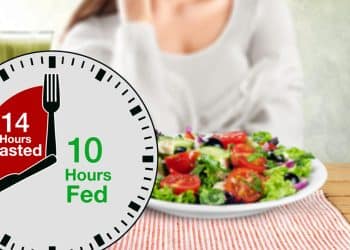Autophagy, a vital cellular process, involves the degradation and recycling of cells’ unnecessary or malfunctioning components via a lysosome-regulated mechanism, ensuring efficient cellular renewal and maintenance.
Drawing from a decade of experience as a healthcare provider, I’ve encountered numerous clients intrigued by the concept of autophagy.
People want to learn what autophagy is all about, whether it brings real benefits, and if there’s a way to induce it through diet or exercise.
These questions can keep health-conscious individuals up at night. And let me tell you, there’s a lot to unpack when it comes to the inherent advantages of autophagy.
This article will cover autophagy in depth, including what it can do and how your body functions around it.
What is Autophagy?

Level Up Your Fitness: Join our 💪 strong community in Fitness Volt Newsletter. Get daily inspiration, expert-backed workouts, nutrition tips, the latest in strength sports, and the support you need to reach your goals. Subscribe for free!
You know the human body comprises trillions of cells made of smaller molecules. These are the basic units of life that form an organism.
These cells perform various functions, such as storing, manufacturing, transporting, and generating energy. If these don’t function well, they affect the corresponding tissues and the underlying organs.
All cells should carry out their assigned responsibilities efficiently. But how do we ensure the appropriate functioning of cells? These components are the cell organelles responsible for different mechanisms, much like the organs inside a human body.
For example, the nucleus is a vital cell organelle that stores a body’s DNA or genetic code. The ribosomes assemble proteins, mitochondria produce chemical energy, lysosomes break down macromolecules into smaller molecules with the help of enzymes, endosomes transfer extracellular material inside the cell, and so on.
The cell is surrounded by a plasma membrane called endoplasmic reticulum (ER), and a gelatinous fluid called cytoplasm flows inside it. It is where autophagy takes place.
The word autophagy combines two words, auto and phagy, which, when combined, mean eating on its own. It is a process in which the defective cells eat themselves up for survival to adapt to nutritional changes or degrading substances harmful to the body. Based on it, autophagy is termed non-selective, primarily a starvation response, or selective autophagy, where a specific group of cells is attacked.
Thus, autophagy eliminates or recycles unwanted or defective proteins, lipids, intracellular pathogens, or components in a cell that form due to stress and aging. This stress can be due to internal or external factors and can also be induced. As autophagy begins, the cells audit their components, remove any unwanted material, and recycle what they can reuse.
Defective proteins can cause several systematic and neurological diseases that lead to misfolding and protein accumulation in the body, which can cause tissue damage and organ dysfunction. [1]
This cleanup improves cell homeostasis and creates energy to survive or reproduce new cells. We will discuss this more shortly in the benefits of autophagy section.
The complex chemical reactions in autophagy are triggered when the cells lack the nutrients they need to survive. During this process, the cell space is cleared, efficiency is improved, and other dysfunctions are reduced.
Three types of autophagy go inside the body — macroautophagy, microautophagy, and chaperone-mediated autophagy. Autophagy, in general, refers to macroautophagy.
Now that you know what instigates autophagy, let us investigate how the mechanism works.
How Does Autophagy Work in the Body?
The process of autophagy is carried out in four steps: sequestration, infusion, degradation, and energy generation. The lack of any type of essential nutrient or oxygen triggers autophagy. A complete absence of amino acids strongly induces autophagy in many cells.
A minimal amount of autophagy happens all the time in the human body. But the pace is languid. So, fasting and exercise are recommended to increase the autophagy rate.
A body continuously needs energy to function. When no additional energy sources are coming in during the fasting phase, it conserves whatever little it has. The cells go into a shock and cannot perform to their capacity, inducing an optimization process by removing unwanted material.
Here is what happens within the autophagy process:
- Sequestration: An isolation membrane is created around the defective component of the cell. In other words, once matured, a phagophore starts forming inside the cytoplasm and converts itself to a double membrane structure called an autophagosome.
- Infusion: The autophagosome interacts with the lysosomes and endosomes in the cytoplasm to degrade its material. These are the essential organelles that carry the process of autophagy.
- Degradation: The lysosomes release enzymes called hydrolases, breaking down the defective cells.
- Energy generation: The unwanted components are removed, while the remaining are recycled into usable components such as amino acids, fatty acids, nucleotides, and glucose.
Many ATG proteins regulate and control this autophagosome biogenesis or the entire process of autophagy. The amino acids form protein molecules, such as adenosine triphosphate or ATP, to fuel the cells to maintain, repair, and rebuild them. Around 20 such ATG proteins trigger the formation of the isolation membrane. [2]
The process helps in eliminating faulty cell components, even in acute neurodegenerative diseases like Alzheimer’s.
Benefits of Autophagy
Level Up Your Fitness: Join our 💪 strong community in Fitness Volt Newsletter. Get daily inspiration, expert-backed workouts, nutrition tips, the latest in strength sports, and the support you need to reach your goals. Subscribe for free!
The benefits of autophagy can be seen both within and outside the cells. There would be a low disease risk as the cell damage is reduced and their functioning improves.
So autophagy has been associated with benefitting cancer patients and people with neurodegenerative diseases like Alzheimer’s and Parkinson’s and ensuring stability in DNA.
However, studies have shown contradictory effects of autophagy on suppressing tumors, liver-related diseases, and many others. So, regulated autophagy is required to target a particular ailment and the associated cells for maximum benefit. Here is a brief on each of these:
Prevents Tumor Formation
Scientists’ research on the association of autophagy with cancer is contradictory. While some studies show that autophagy kills the cancer cells, others show that it facilitates their multiplication. [3]
Avoid Neurodegenerative Diseases
Toxic aggregated proteins and loss of cells that conduct nerve impulses in the human body are the underlying causes of neurodegenerative diseases. Regulated autophagy reduces the possibility of these diseases and ensures better transmission of nerve signals in the brain. However, its overactivation can also have detrimental effects. [4]
Reduces Liver Problems
Autophagy can reduce the development of liver diseases, but the impact depends on the stage of the disease and the context of the disease. In contrast, it might induce cell death and lead to disease progression. Studies indicate that interference in the autophagy mechanism opens new ways of treatment for liver diseases. [5]
Balancing Nutrients for Energy Demand
Autophagy proteins or ATGs regulate the secretion of various hormones, cytokines, and neurotransmitters, thus balancing nutrient and energy consumption in the body. [6]
Eliminates Pathogens
The primary function of autophagy is to degrade and clear invading viruses from the cytoplasm. It also facilitates antigen processing at the later stage of infection by inducing an adaptive immune response. [7]
Decreases Cell Aging Speed
With aging, the natural process of autophagy diminishes, and people become prone to diseases. You can reverse the process and live longer by eliminating the cell debris through autophagy.
Decreases Oxidative Stress
Oxidative stress contributes to almost all chronic diseases, such as cardiovascular and neurodegenerative diseases, diabetes, and cancer, due to structural defects in the cells. These might lead to alterations in the production of enzymes and aberrations in DNA and gene expression.
It is primarily an imbalance of free radicals or ROS (Reactive Oxygen Species) in the Mitochondria and the inability of antioxidants to tame them. Autophagy reduces oxidative stress by clearing protein aggregates and removing irretrievably oxidized biomolecules and damaged mitochondria. [8]
Reduction in Inflammation
Bacterial and viral infections trigger inflammation by activating immune cells to protect the body. Autophagy degrades these stimuli and induces and modulates the inflammatory reaction. But, if it is not controlled, it can lead to epithelial cell death. [9]
How Do You Trigger Autophagy and Increase Its Effect?
We know autophagy is a result of stress on cells. Here are some ways you may trigger autophagy:
- Fasting: Fasting can induce autophagy. However, it must be done for at least 24 hours.
- Stress: The reasons for this stress could be DNA damage, hypoxia or lack of oxygen, pathogen infection, and ER stress, which can also induce autophagy. [10]
- Certain drugs: Medications can also induce autophagy. In response, the body generates more ATP to get the energy needed to function. [11]
- Exercise: Physical activity or high-endurance exercise is another way to trigger autophagy.
So, what type of fasting helps the most for autophagy? Whether you are picking an intermittent fasting diet or a low-carb or keto diet, you should avoid consuming proteins and other nutrients for a significant duration. Autophagy gets triggered when you start fulfilling the body’s energy requirements from glucose to fat. A diet that triggers ketosis is most likely to speed up autophagy. You should always consult a registered dietician before picking any sort of fasting or calorie-restricting diet.
How Long to Fast for Optimal Autophagy
Researchers have mixed opinions on this. While some studies indicate that autophagy occurs during 16:8 intermittent fasting, some say that an average of 36 hours is required for a considerable effect.
Some short fasting or caloric restriction can boost the process, but most research indicates that it triggers at least after 24 hours of fasting. [12]
Exercise equally helps in inducing stress in the body, aiding in autophagy. It quickly eats up the body’s glucose resources and sends it hunting elsewhere. The survival process instigates the cells to eat themselves up.
Ideally, you should not push for autophagy; instead, try to maintain homeostasis. Any sudden change in diet or exercise is never advisable to induce autophagy.
FAQs
Can drinks affect autophagy?
Calorie-laden drinks trigger an insulin response in the body. Insulin activates the mechanistic Target of Rapamycin (mTOR) protein, directly hampering the autophagy process.
How long should I fast for the best autophagy benefits?
While shorter fasting periods or caloric restriction can still contribute to the process, hitting the 24-hour mark is a crucial threshold for maximizing autophagic benefits.
Is autophagy good for the lungs?
Autophagy helps in reducing lung inflammation but is not effective for asthma patients. Depending on the type and stage of the disease, regulated autophagy is required to have the necessary benefits. [13]
Conclusion
Autophagy is the process of self-clearance where the body’s cells naturally cleanse themselves to discard unwanted matter and reuse the remains for energy production. It is activated either with starvation to cope with the energy needs or to eliminate the harmful pathogens identified within the cells.
Some autophagy is a continuous process that goes on inside the human body but at a slow pace. You can also artificially trigger it through fasting. But, you must fast for at least 24 hours to see the results. Also, depleting energy through exercise can trigger autophagy as the body copes with increased energy demand.
Autophagy has many benefits, from reducing tumors, inflammation, and viral infections to lowering oxidative stress, attributing to neurodegenerative diseases, and balancing nutrient and energy demand. But, for many of these benefits, autophagy should be regulated. Since the autophagy effect varies with the cell type and the stage of the disease, the end goal for medical practitioners is to target specific body cells and symptoms for better clinical results.
References
- Soto, C. (2006, September 13). Defective Protein Folding Disorders. Springer eBooks.
- Li, X., He, S., & Ma, B. (2020, January 22). Autophagy and autophagy-related proteins in cancer. Molecular Cancer.
- Yun, C. W., & Lee, S. H. (2018, November 5). The Roles of Autophagy in Cancer. International Journal of Molecular Sciences.
- Guo, F., Liu, X., Cai, H., & Le, W. (2018, January). Autophagy in neurodegenerative diseases: Pathogenesis and therapy. Brain pathology (Zurich, Switzerland).
- Ke PY. Diverse Functions of Autophagy in Liver Physiology and Liver Diseases. Int J Mol Sci. 2019 Jan 13;20(2):300. doi: 10.3390/ijms20020300. PMID: 30642133; PMCID: PMC6358975.
- He, C. (2022, June 1). Balancing nutrient and energy demand and supply via autophagy. Current Biology.
- Mao J, Lin E, He L, Yu J, Tan P, Zhou Y. Autophagy and Viral Infection. Adv Exp Med Biol. 2019;1209:55-78. doi: 10.1007/978-981-15-0606-2_5. PMID: 31728865; PMCID: PMC7122562.
- Wang, F., & He, Z. (2013, January 1). Axon Maintenance and Degeneration. Elsevier eBooks.
- Netea-Maier RT, Plantinga TS, van de Veerdonk FL, Smit JW, Netea MG. Modulation of inflammation by autophagy: Consequences for human disease. Autophagy. 2016;12(2):245-60. doi: 10.1080/15548627.2015.1071759. Epub 2015 Jul 29. PMID: 26222012; PMCID: PMC4836004.
- King JS, Veltman DM, Insall RH. The induction of autophagy by mechanical stress. Autophagy. 2011 Dec;7(12):1490-9. doi: 10.4161/auto.7.12.17924. PMID: 22024750; PMCID: PMC3327616.
- Thellung S, Corsaro A, Nizzari M, Barbieri F, Florio T. Autophagy Activator Drugs: A New Opportunity in Neuroprotection from Misfolded Protein Toxicity. Int J Mol Sci. 2019 Feb 19;20(4):901. doi: 10.3390/ijms20040901. PMID: 30791416; PMCID: PMC6412775.
- Shabkhizan R, Haiaty S, Moslehian MS, Bazmani A, Sadeghsoltani F, Saghaei Bagheri H, Rahbarghazi R, Sakhinia E. The Beneficial and Adverse Effects of Autophagic Response to Caloric Restriction and Fasting. Adv Nutr. 2023 Sep;14(5):1211-1225. doi: 10.1016/j.advnut.2023.07.006. Epub 2023 Jul 30. PMID: 37527766; PMCID: PMC10509423.
- Painter, J. D., Galle-Treger, L., & Akbari, O. (2020, July 7). Role of Autophagy in Lung Inflammation. Frontiers in Immunology.












